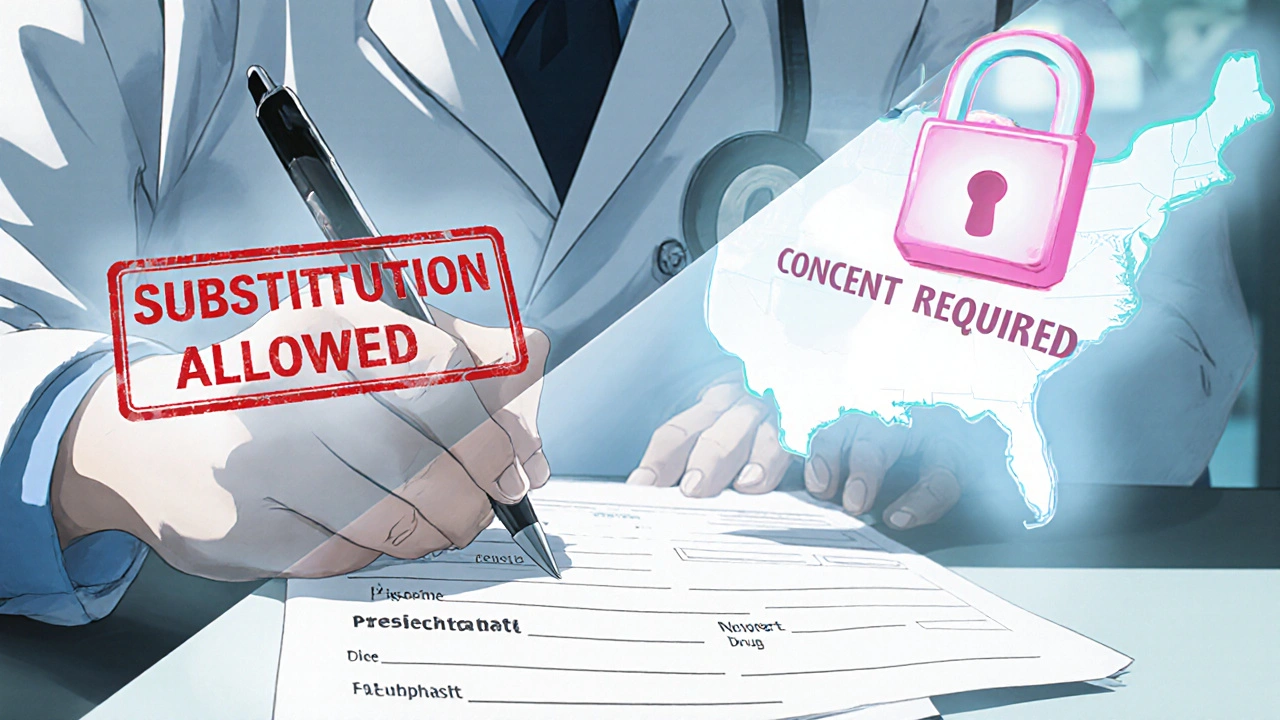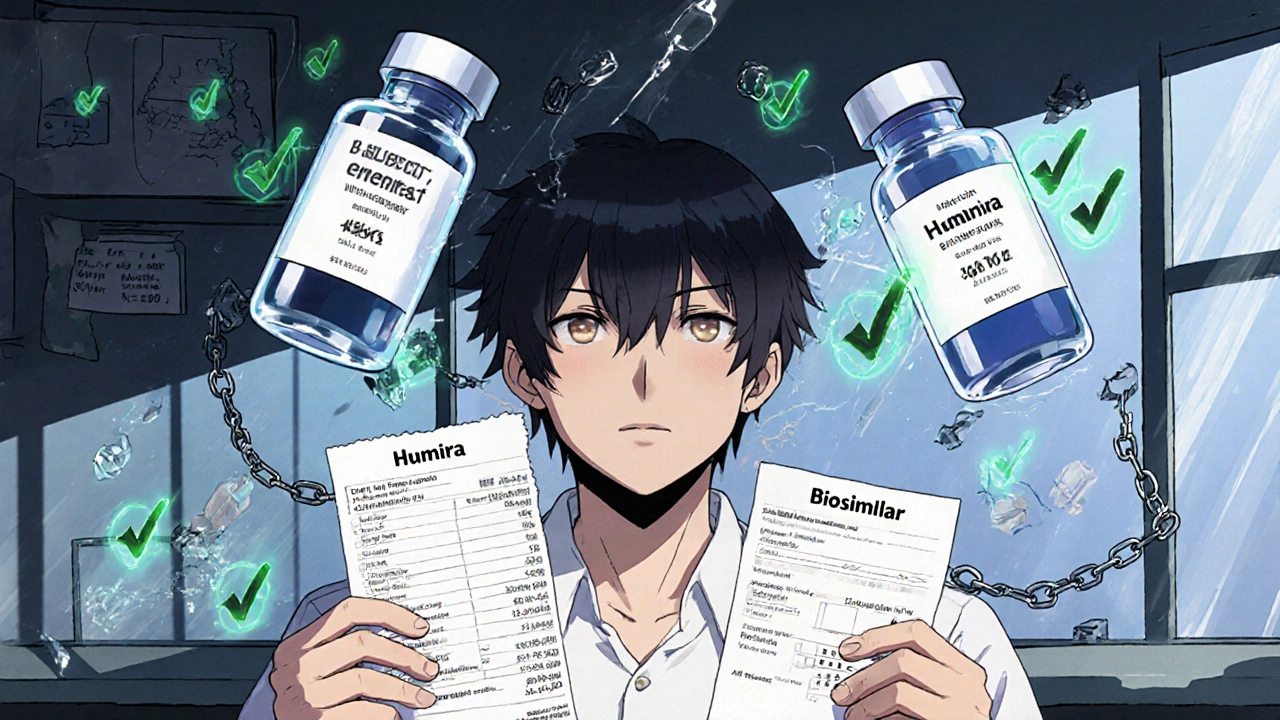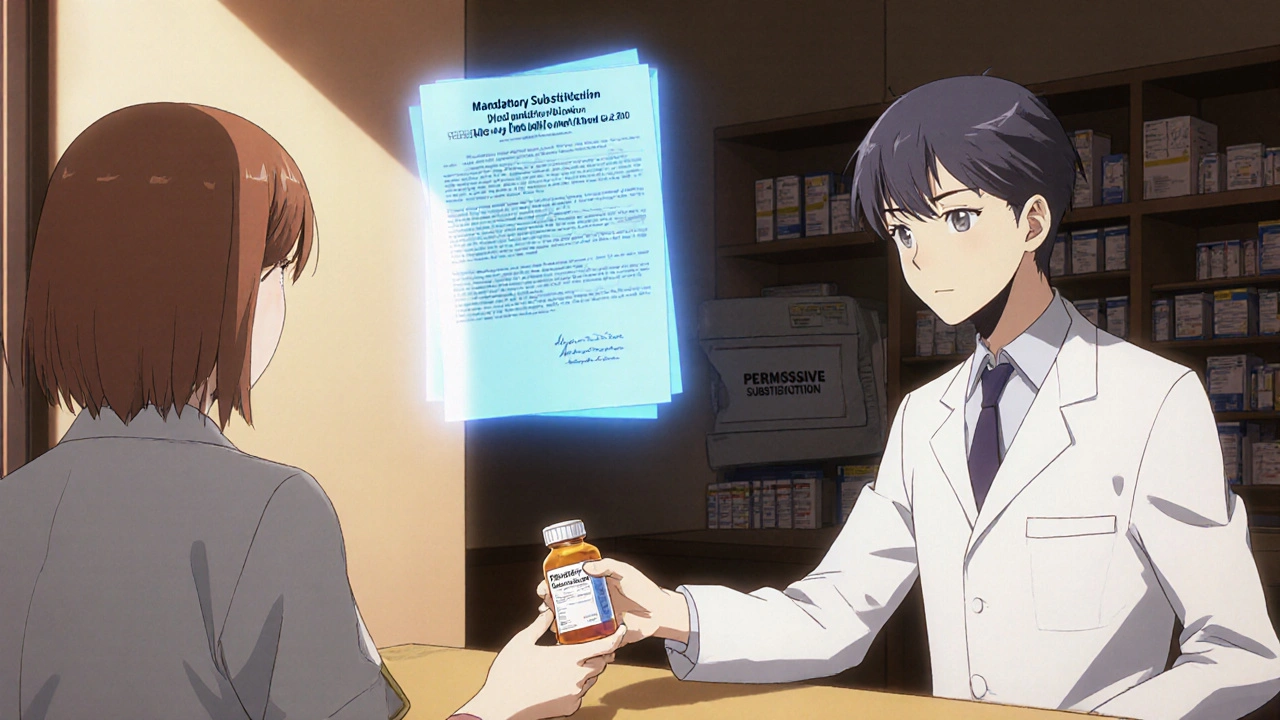When you pick up a prescription, you might assume the pharmacist will give you the cheapest version of your medicine - and in many places, they must. But in others, they can only offer it if you say yes. This isn’t about pharmacy policy. It’s about state law. And the difference between mandatory and permissive substitution can save you hundreds a year - or cost you your adherence to treatment.
What’s the Real Difference Between Mandatory and Permissive Substitution?
Mandatory substitution means the pharmacist is legally required to swap your brand-name drug for a generic version - unless your doctor specifically says not to. Permissive substitution means they’re allowed to make the switch, but only if they choose to. No law forces them. And in some states, even that choice is blocked unless you give written consent. This isn’t a minor detail. It’s the difference between a 48.7% generic fill rate and a 30% one. That’s based on real data from simvastatin prescriptions after patent expiration. In mandatory states, nearly half of all prescriptions were filled with generics. In permissive ones, only three in ten were. Why? Because when substitution is optional, pharmacists often don’t bring it up. Patients don’t ask. And without a push from the law, the brand-name drug stays on the shelf - even when the generic is just as safe and costs 80% less.Which States Force Substitution? Which Ones Don’t?
As of 2020, 19 states require pharmacists to substitute generics unless the prescriber writes "Dispense as Written" or "Brand Medically Necessary" on the prescription. These include Alabama, Alaska, Arizona, Arkansas, Colorado, Connecticut, Delaware, Idaho, Indiana, Kentucky, Louisiana, Maine, Maryland, Massachusetts, Mississippi, Montana, New Hampshire, North Dakota, and West Virginia. The other 31 states and Washington, D.C. use permissive substitution. In those places, the pharmacist can substitute - but doesn’t have to. And in some of those states, they can’t even substitute unless you sign a form. Seven states plus D.C. require explicit patient consent before switching. That means the pharmacist has to stop, explain the switch, and get your signature. It sounds reasonable - until you see the data. In those states, only 32.1% of simvastatin prescriptions were filled with generics. In states with no consent requirement, that number jumped to 98.1%. So consent isn’t about safety. It’s a barrier. And it works.How Do Prescribers Block Substitution?
Doctors have the final say - but how they say it varies wildly by state. In some states, prescriptions come on two-line forms. The top line is the drug name. The bottom line is where the doctor checks a box that says "Allow substitution." If they leave it blank, substitution is automatic. In states without this format, the doctor must write out "Do Not Substitute," "Dispense as Written," or "Brand Medically Necessary" by hand. This creates confusion. A doctor in New York might write "Do Not Substitute" on a prescription. The patient travels to Texas - where substitution is mandatory. The pharmacist in Texas sees the note and still can’t override the law. The patient gets the brand drug. The doctor didn’t know the rules changed at the border. Worse, some states require prescribers to justify why they’re blocking substitution. Others don’t. That means the same doctor, writing the same note, might have different outcomes depending on where the pharmacy is.
Why Do Some States Block Substitution With Patient Consent?
The argument for consent is simple: patients deserve to know. But the data tells a different story. Generic drugs aren’t cheaper because they’re worse. They’re cheaper because they don’t need expensive marketing, clinical trials, or patent protection. The FDA requires them to be bioequivalent - meaning they work the same way in your body. Yet in states that require consent, pharmacists are twice as likely to avoid substituting narrow therapeutic index drugs - like warfarin, levothyroxine, or seizure meds - even when the generic is approved. Why? Because they’re scared of liability. And in 24 states, there’s no legal protection for pharmacists who substitute generics. If something goes wrong, they could be sued - even if the generic was FDA-approved. That fear isn’t theoretical. Pharmacists in mandatory states without consent rules report fewer delays and fewer patient complaints. In consent-required states, they spend extra time explaining, documenting, and waiting. It slows down the whole system.Biosimilars Are Changing the Game
It’s not just pills anymore. Biologics - complex drugs made from living cells - are now a huge part of prescriptions. Think Humira, Enbrel, or insulin analogs. They cost $10,000 to $20,000 a year. Biosimilars are the generic version. But they’re not as simple as a pill swap. Your body might react differently. So states treat them differently. Forty-five states have stricter rules for biosimilar substitution than for regular generics. Most require the doctor to give explicit permission before switching. Some require notification to the patient, recordkeeping, and even tracking which biosimilar was used. Only nine states and D.C. treat biosimilars the same as small-molecule generics. That means if you’re on a biologic, your chances of switching to a cheaper version depend almost entirely on where you live.
What This Means for Your Health and Wallet
If you’re on a chronic medication - high blood pressure, cholesterol, diabetes, depression - the state you live in could be costing you thousands. A 2011 Congressional Budget Office study estimated that increasing generic use by just 1% would save Medicare Part D $160 million a year. Multiply that by the 18.7 percentage point gap between mandatory and permissive states - and you’re looking at billions in savings. But savings aren’t just about money. They’re about adherence. People who get generics are more likely to keep taking their meds. Why? Because they can afford them. A study in Medicaid populations found that patients in mandatory substitution states had better refill rates and fewer hospital visits. The savings weren’t just in drug costs - they were in emergency room visits, doctor visits, and complications from untreated conditions.What Should You Do?
You can’t change state law. But you can control what happens at the pharmacy counter. 1. Always ask: "Is there a generic version?" Don’t wait for them to offer it. 2. Check your prescription: Does it say "Dispense as Written"? If so, you’re blocking substitution. Ask your doctor if that’s really necessary. 3. Know your state: If you live in a mandatory state, you’re already getting the generic unless your doctor says otherwise. In permissive states, you need to speak up. 4. Track your costs: If your copay jumps after a refill, ask why. Did they switch you back to brand? Did they use a different generic? Keep receipts. Compare prices. 5. Use pharmacy apps: Many apps show you the lowest price for your drug - generic or brand - at nearby pharmacies. Use them.Why This Matters Beyond the Pharmacy
This isn’t just about pills. It’s about how the system is designed. The federal government created the FDA’s Orange Book to list which generics are therapeutically equivalent. But the law says states get to decide if and how those generics are used. That means a patchwork of rules - some smart, some outdated, some actively harmful. The result? A system that’s confusing for patients, risky for pharmacists, and profitable for brand manufacturers. And it’s not getting simpler. With more biologics, complex drugs, and specialty medications entering the market, the gaps between states will only grow. The only way to fix it is awareness. Patients who know their rights. Pharmacists who know their laws. Doctors who know the impact of their notes. Because in the end, substitution isn’t about chemistry. It’s about choice. And the law should make the right choice the easy one.Is generic substitution the same in every state?
No. 19 states require pharmacists to substitute generics unless the doctor says not to. The other 31 states and Washington, D.C. allow substitution but don’t require it. Some of those states also require patient consent, which can reduce generic use by more than two-thirds.
Can my doctor prevent me from getting a generic drug?
Yes. In every state, a doctor can write "Dispense as Written," "Do Not Substitute," or "Brand Medically Necessary" on the prescription. But in some states, they must also provide a reason. In others, no explanation is needed. The law varies.
Why do some states require patient consent for generic substitution?
Some states require consent to give patients control over their medication. But data shows it reduces generic use dramatically - from 98% in states without consent to under 35% in states with it. The real effect is often less about safety and more about slowing down substitution, which benefits brand-name drug manufacturers.
Are biosimilars treated the same as regular generics?
No. Forty-five states have stricter rules for biosimilars - the generic versions of complex biologic drugs. Most require doctor approval, patient notification, and detailed recordkeeping. Only nine states and D.C. treat them the same as regular generics.
Can I be charged more if I get a brand-name drug instead of a generic?
Yes. In many cases, your insurance will charge a higher copay for brand-name drugs if a generic is available. Some pharmacies also charge more for the brand version. Always ask about pricing before you leave the counter.
What should I do if my pharmacist won’t substitute my drug?
Ask why. If you live in a mandatory substitution state and they refuse without a "Dispense as Written" note, they may be breaking the law. Ask to speak to the pharmacist-in-charge. If you’re in a permissive state, ask if they can switch you to a cheaper generic - even if they don’t have to.
Does substitution affect how well my medication works?
For most drugs, no. The FDA requires generics to be bioequivalent to brand-name drugs - meaning they work the same way in your body. For narrow therapeutic index drugs like warfarin or levothyroxine, switching can sometimes cause issues, but that’s rare and usually only happens with poor quality control or frequent switching - not with a single, FDA-approved substitution.



Katelyn Sykes
November 18, 2025 AT 15:53Just got my levothyroxine refill and they tried to switch me to a new generic-no warning, no consent. I asked why and they said 'it's cheaper.' I asked if it was the same and they shrugged. That's the problem. Law or no law, if pharmacists don't explain, patients get scared and stop taking it. We need better communication, not just mandates.
Gabe Solack
November 20, 2025 AT 15:40Bro this is wild 😮 I work at a pharmacy in Texas and we’re permissive but half the time patients don’t even know generics exist. One guy came in crying because his insulin cost $800 and he didn’t realize the biosimilar was $200. We had to call the doctor. Laws need to change. Pharma’s laughing all the way to the bank.
Yash Nair
November 21, 2025 AT 22:54USA is so weak why let states decide this shit. In India we just give generic first full stop. No consent no drama. Brand drugs are for rich people who dont care about money. This whole system is corrupt and designed to keep people sick so they keep buying expensive pills. Wake up america
Shaun Barratt
November 23, 2025 AT 18:05There’s a critical flaw in the assumption that consent requirements are purely paternalistic. In practice, they often serve as a safeguard against pharmacists who, under pressure to reduce costs, may substitute without verifying bioequivalence or patient history. The 98.1% figure cited is misleading-it conflates substitution rate with appropriate substitution. Quality control matters more than speed.
Kristina Williams
November 24, 2025 AT 14:07They don't want you to know this but the FDA is in bed with big pharma. The 'bioequivalent' claim is a lie. Generics are made in China with different fillers. They don't work the same. That's why people get worse after switching. They're testing on poor people to save money. This is a controlled experiment and you're the lab rat.
Brenda Kuter
November 25, 2025 AT 12:47MY SON GOT SEIZURES AFTER THEY SWITCHED HIS MEDS WITHOUT TELLING ME. I WAS OUT OF THE ROOM. THE PHARMACIST JUST HANDED HIM A NEW BOTTLE. NOW HE CAN'T WALK PROPERLY. THIS ISN'T ABOUT MONEY. THIS IS ABOUT PEOPLE DYING BECAUSE SOMEONE WAS TOO LAZY TO ASK. I'M TAKING THIS TO THE MEDIA.
Sarah Frey
November 27, 2025 AT 01:14While the data on substitution rates is compelling, I worry that the framing overlooks the emotional weight patients carry when changing medications. For many, especially those with chronic conditions, the brand name feels like stability. The law shouldn’t force change-it should support informed choice. A simple conversation, not a signature, is what’s needed.
Denny Sucipto
November 27, 2025 AT 19:36Man I used to work at a clinic in Ohio and we had folks on warfarin who switched generics every month-different makers, different fillers. One guy ended up in the ER with a bleed. It wasn’t the drug-it was the churn. We started keeping a log of which generic they got and stuck with it. That’s the real fix: consistency, not just substitution. Let people stay on the same batch unless there’s a real reason to switch.
Hal Nicholas
November 28, 2025 AT 13:52You think this is bad? Wait till biosimilars hit the market for biologics like Humira. The FDA approved them, but the companies are already suing states that allow substitution. This isn’t about safety-it’s about profit. The entire system is rigged. You’re not a patient. You’re a revenue stream.
Louie Amour
November 28, 2025 AT 19:43It’s laughable that you think patients are capable of making informed decisions about pharmacokinetics. Most can’t even read a prescription label. Mandatory substitution isn’t just ethical-it’s the only responsible policy. Letting pharmacists ‘ask’ is a luxury for the privileged. The rest of us need the system to work for us, not with us.
Shilpi Tiwari
November 30, 2025 AT 19:20From a pharmacoeconomic standpoint, the variance in substitution laws creates massive inefficiencies in supply chain logistics. Tiered formularies, rebate structures, and PBM negotiations are all distorted by state-level heterogeneity. Harmonizing substitution protocols would reduce administrative burden by 30-40% and accelerate formulary adoption of biosimilars-especially critical for Medicaid populations with high biologic utilization.
Girish Pai
December 2, 2025 AT 00:07India has 100% generic substitution and it works. No consent. No paperwork. No drama. Why? Because we trust the science and we don't let corporations control health. America is broken. You pay more for less. You're being played. Fix your system or get ready for the next pandemic where your meds don't work because you're too rich to afford generics.